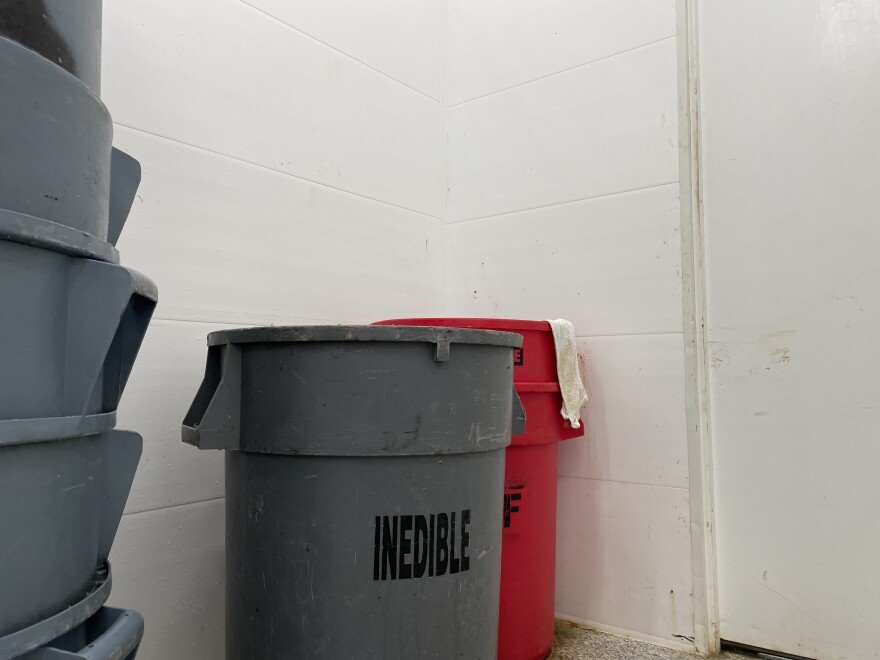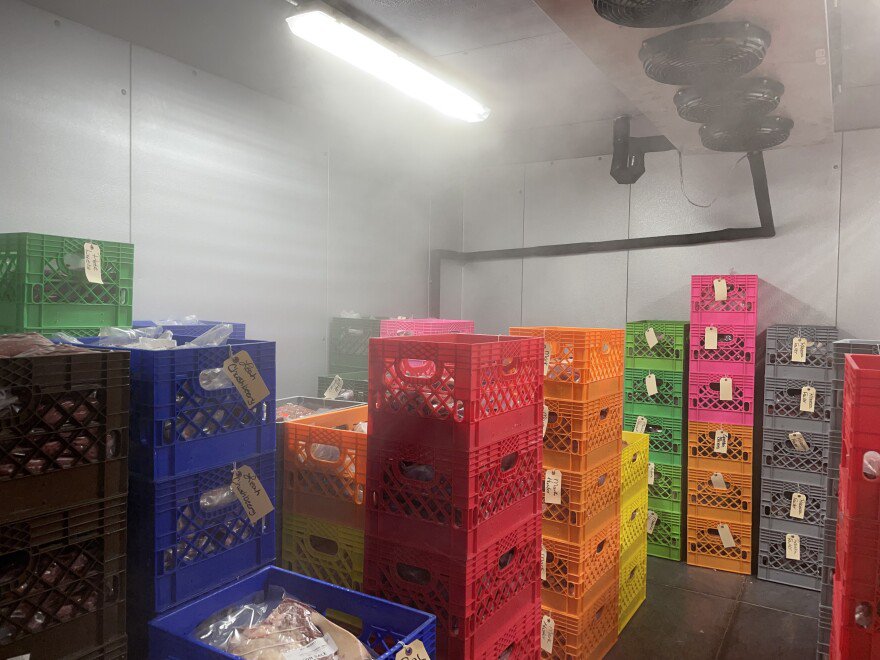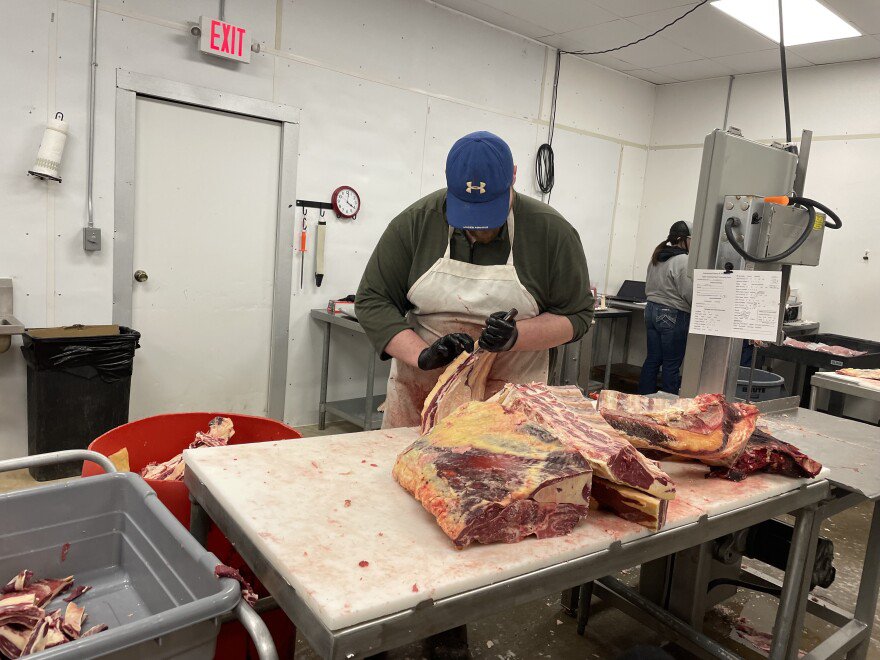12.20.21 Harvest Public Media: Getting Rid of Cow Guts, Scraps Holds Back Small Meat Processors
Getting Rid of Cow Guts, Scraps Holds Back Small Meat Processors
By Seth Bodine, Harvest Public Media
Dec. 20, 2021,
Brian Lane, owner of Tonkawa Processing Corporation in Tonkawa, Oklahoma, stands in a freezer full of cow carcasses. Lane received a grant from the state to expand the processor to be federally inspected so ranchers can sell meat across state lines. (Photo by Seth Bodine, Harvest Public Media)
When cattle go to slaughter, America’s factory-scale processors make a buck off more than ground beef and steak.
They squeeze profit from the carcasses by finding markets for the tongues, the hearts and less appetizing parts of the animal.
Smaller processors — increasingly championed as a competitor that might offer ranchers a better deal and consumers a chance to buy local — actually have to shell out money to get rid of those extra parts.
Even as tax dollars increasingly subsidize those small businesses, they struggle to make a profit while bearing the expenses of getting rid of the byproducts.
The U.S. Department of Agriculture is funneling $600 million in grants and loans from President Joe Biden’s recently passed infrastructure plan to help small-scale meatpackers expand, even as those mom-and-pop companies wrestle with what to do with their leftovers.
Brian Lane recently bought Tonkawa Processing Corp. and got a grant of CARES Act money from the state to expand and bring in federal food inspectors so the meat can be sold across state lines. People drive up to 100 miles away to get their animals slaughtered and processed.
Despite occasional requests for tongues, livers and hearts, the rest of the animal gets put into large plastic barrels with the word “inedible” imprinted on it, and gets thrown in the trash or awaits the pickup of a rendering plant that recycles it into another product.
Barrels filled with hides and cow organs sit inside a room in Tonkawa Processing Corp. in Tonkawa, Oklahoma. The spare parts of the animal either gets taken by a rendering company to be recycled or thrown away. (Photo by Seth Bodine, Harvest Public Media)
“I looked at doing a couple of hides, having them tanned and it’s about $1,500 or you can buy one that is already tanned for $150 to $250,” Lane said.
Lane said he pays a rendering company to pick up the parts twice a week.
A weight on the little guy
Beef byproducts show up in almost every single aisle of the grocery store, said Dan Hale, a meat specialist at Texas A&M University. They’re key ingredients in marshmallows, lipstick and glycerin.
But the companies who transform those renderings need them in huge quantities to balance their own spreadsheets. Small quantities aren’t economically practical. It only works, Hale said, when “one truck can go pick up a large amount of product.”
Cow livers, hearts, tongue and tallow are sold around the world to countries like Japan, Egypt and China, said Joe Schuele, a spokesman for the U.S. Meat Export Federation. He said many small processors contract with trading companies in order to sell overseas.
Colorful, labeled crates filled with meat sit in a freezer in Tonkawa Processing. Customers bring their animals to the business to be slaughtered and harvested for meat. (Photo by Seth Bodine, Harvest Public Media)
Lane doesn’t see that as an option — his processor doesn’t have a storefront, and he doesn’t own the animals or its parts.
“If somebody approached us and wanted us to do it, we might start talking to customers about it then and work something out,” he said. “But a small processor in Northern Oklahoma is probably not going to do a bunch or international business.”
Meanwhile, the value of hides, tongues, hearts and other products has been increasing, according to a blog post by Oklahoma State University Extension. Hides, for example, have more than doubled in price in the last year.
But small meatpackers can’t cash in.
That’s an obstacle as states and the USDA try to boost local processors to strengthen the supply chain and promote competition in the meat industry.
“A small processor in Oklahoma not only doesn’t usually get any value out of that … they actually pay somebody to take it away,” said Derrell Peel, a livestock marketing specialist with Oklahoma State University. “And that’s one of the bigger challenges of trying to expand this small processor capacity in any state.”
Economies of scale
Part of the reason for the discrepancy between profit comes down to scale.
“If you get bigger, you become more efficient,” said Courtney Bir, an agricultural economist said. “Larger packers can contract with different groups to, let’s say, get the hides to a tanning facility for further processing.”
Homestead Meats, a local meat processor near Guthrie, Oklahoma, received money to expand and sell products like hearts and livers for customers to eat or use for raw dog food alongside standard cuts of meat. Occasionally, the business will get requests for other parts like eyeballs, said Jamie LaRue, an owner of Homestead.
Mostly, LaRue pays a rendering company to take the parts away, or it goes in the trash. In November, she paid about $700 to get rid of the byproducts of roughly 100 cattle and other animals. Conversely, a big meatpacker can make around $168 per head of cattle from those byproducts, Peel said.
“They (big meatpackers) are able to sell every single thing from the hoof up through extra bones,” LaRue said. “All of the internal organs, guts, eyeballs, heads, I mean everything. They have a market for it all to go. Instead, here we’re basically just dumping it in the trash, we have no place for it to go.”
The costs end up going to the consumer in the price of meat, Chris Brundick said, a farmer and owner of Farmers Meat Market in Vienna, Missouri. Brundick got a state grant to open his facility and said it would have been impossible without that money.
“That is a reason why there aren’t enough or hasn’t been enough of these facilities is just because of the financial hurdles and trying to get it to cash flow and keeping a workforce in place,” Brundick said.
Local meat, for sale
Some small processor owners are optimistic that they will find a way to dispose of leftovers without making a dent in the budget, and are marketing to consumers who want local meat.
An employee carves up a carcass at Homestead Meats near Guthrie, Oklahoma. (Photo by Seth Bodine, Harvest Public Media)
Alex Parker started Circle P Processing in Waterville, Kansas, when he was angered by the rising price of meat.
“We had a family dinner. It was my grandmother’s birthday and … simply put, I couldn’t afford the steaks for everybody and I got mad,” Parker said. “So I wound up taking a piece of notebook paper and started drawing it out and figuring things out for the next year.”
His facility is one of eight processors in Kansas that got federal money to expand.
As his business grows, Parker hopes to buy composting technology that would help him render byproducts on his own, which he thinks will be beneficial.
“Even if I don’t turn around and sell (fertilizer made from compost), we’ll apply it to our farm ground,” Parker said. “And we’ll put the nutrients and everything back into the ground, which then increases our yield on our crops, and so on and so forth.”
Owners like LaRue in Oklahoma occasionally get requests for organs for raw dog food or to consume. But mostly, she’s relying on people who want local meat.
“We opened right before COVID hit,” she said. “We immediately, I mean, we were extremely blessed, we had just floods of people looking for local beef, or selling local beef that needed to have it processed.”



